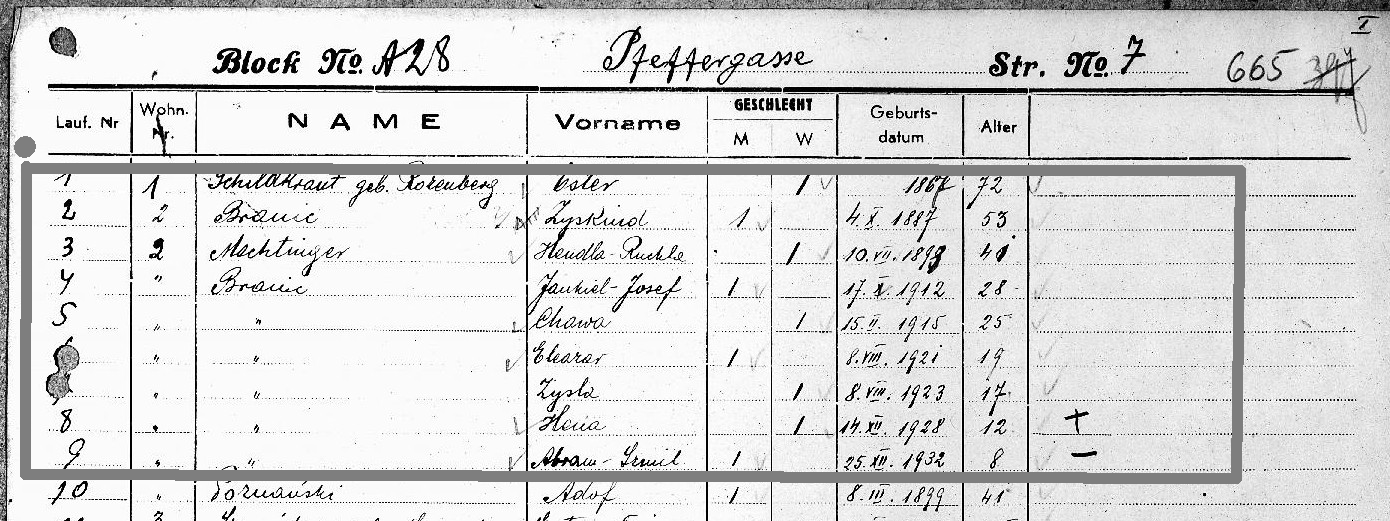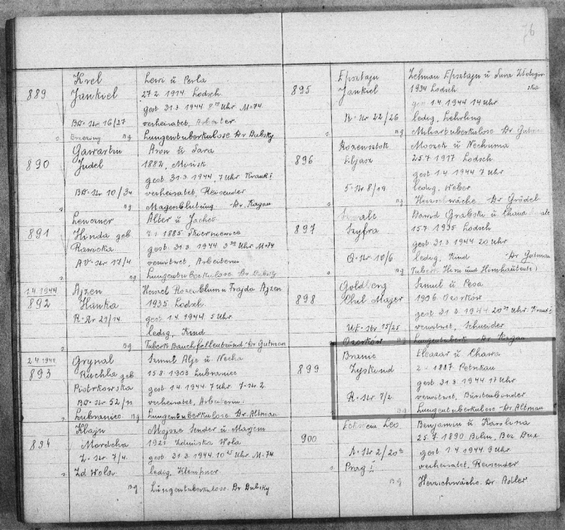The Biography of Zosia Nachman, née Branic, Lodz
Short biography and stations of her persecution
- born on June 6, 1925 in Lodz/Poland, née Branic,
- From December 1940, she had to wear the yellow Judenstern
- 4/30/1940 - August 1944 Lodz Ghetto, making straw shoes for the Wehrmacht
- August 1944 Auschwitz, after 10 days
- Bergen-Belsen
- December 2, 1944 - April 16, 1945 Flossenbürg/Plauen/Mehltheuer concentration camp, #59473, production of aircraft parts (date in file: mid-October 1945 - April 16, 1945)
- DP camp Feldafing,
- DP camp Landsberg
- 1947 IRO camp Barletta,
- 1950 USA
Zosia Nachman lost her parents and five siblings as a result of the persecution. She was 15 years old when her persecution began.
Date of death of parents and siblings:
Father: March 31, 1944
Mother: 1943
Abram-Szmil, Eleazar (August 8, 1921), Jankiel-Josef (May 15, 1912): ?
Chawa (February 15, 1915), Henia (December 14, 1928): deported September 28, 1942
Zosia Nachman was not a client of Konrad Kittl, but she was named as a witness by Tola Cudzynowski. Ms. Nachman belonged to a group of women who shared the same fate of persecution. The witnesses named by her were with her throughout the entire period of persecution:
- Tragerman Genia; April 14, 1924, Lodz, Poland, née Wolf, persecution history: Lodz ghetto, Auschwitz concentration camp, Bergen-Belsen concentration camp, December 2, 1944, Flossenbürg concentration camp/Mehltheuer #59444
- Stolzman, Malka; June 15, 1929, Lodz, Poland, née Gala, persecution history: Lodz ghetto, Auschwitz concentration camp, Bergen-Belsen concentration camp, December 2, 1944, Flossenbürg concentration camp/Mehltheuer #59479
- Stolzman, Malka; June 15, 1929, Lodz, Poland, née Gala, persecution history: Lodz ghetto, Auschwitz concentration camp, Bergen-Belsen concentration camp, December 2, 1944, Flossenbürg concentration camp/Mehltheuer #59479
- Pesa Gutman; born Sonnabend, widowed Nelken, June 21, 1913, Lodz, Poland, persecution history: Lodz ghetto, Auschwitz concentration camp, Bergen-Belsen concentration camp, December 2, 1944 Flossenbürg/Mehltheuer concentration camp #59600
She herself testified to the statements of Mrs. Tola Cudzynowski.
I took the exact date of their arrival in Flossenbürg and the prisoner number, which is partially missing in the records, from the number book “Number Books of the Flossenbürg Concentration Camp, Book 7, Women: Prisoner Number 50000-60000”.
Kittl also represented Felicija Hanfling, who was also in the Łódź Ghetto and was sent to the subcamp Mehltheuer:
- Hanfling, Felicia Faiga; 9.6.1921 Chelm/Poland; née Bienstock; 12/1940-11/1942 Chelm Ghetto, 11/1942-2/1943 Warsaw Ghetto, 2/1943-11/1944? Lodz, KZ Auschwitz, -16.4.1945 KZ Flossenbürg/Mehltheuer, Bamberg, 1950 USA
Before the Persecution
I was in perfect health before the period of persecution and had no physical or nervous complaints. I was a fresh, healthy girl full of life when the period of persecution began.
Source: Affidavit (incarceration) of 1955, Zosia Nachman file, Landesamt für Finanzen, Landesentschädigungsamt, Munich
We were six children, I was the fourth oldest. My parents and my five siblings perished during the period of persecution.
My father made brushes that were taken to the market and sold there. He also supplied individual stores. In addition to my two brothers and my oldest sister, two workers also worked in this business. We were a middle-class family.
Source: Affidavit (health) from 1961, Zosia Nachman file, Landesamt für Finanzen, Landesentschädigungsamt, Munich
Lodz Ghetto
I began to suffer from severe nosebleeds in the ghetto. This started in 1941 and occurred two to three times a week, accompanied by severe headaches and dizziness. [Description of further illnesses] I had to go to work despite my severe stomach pains. The food was very poor and insufficient. Despite my young age, I had to work 10 to 12 hours a day. In 1943, when I was on my way to work in the brush production with my father, an SS man approached us and wanted to shoot my father. I begged the SS man to spare my father. He then beat my father with his rifle, especially over the head, but I don't know what happened next because I fell unconscious. I can't even say whether I was beaten by the SS man or not, because I was unconscious.
I only know that my father and I were helped up by fellow prisoners and taken to work.
Source: Affidavit from 1955, Zosia Nachman file, Landesamt für Finanzen, Landesentschädigungsamt, München
I cannot recall any further details about this incident. But I do know that from that time on I was overcome by great fear and nervousness and lived in constant terror. My headaches have lasted to this day. My father was unable to recover from the abuse described and died after a few months in the camp. This was a great emotional pain for me. My mother died in the ghetto in 1943, unable to bear the grief and fear of the period of persecution. My siblings were killed in “Aktionen” within two weeks of each other. I was left alone and the mental pain of having lost all my loved ones at the hands of the Nazis had a terrible effect on me and left me in a mentally shattered state. I had lost all zest for life and these terrible events still haunt me today in severe nightmares.
Source: Affidavit from 1955, Zosia Nachman file, Landesamt für Finanzen, Landesentschädigungsamt, München
This occupancy plan must have been created in 1940, based on the date of birth and age information. The seven members of the Branic family were: Zyskind, Jankiel-Josef, Chawa, Eleazar, Zysla, Henia, and Abram-Szmul.
This occupancy plan must have been created after September 28, 1942, see the information for Chana and Henia. Their entries are marked “ausgew. 28/9 42” (selected 9/28/42). The remaining members of the Branic family were: Zyskind, Zysla, and Abram. The fate of Jankiel-Josef and Eleazar, who are still listed in the 1940 register, is unknown.

This list must have been compiled after March 31, 1944, as Zyskind Branic is noted as having died on March 31, 1944. See also the entry in the death register.
According to the death register, her father died on March 31, 1944, at 5:00 p.m. from pulmonary tuberculosis, entry number 899.
Quelle: United States Holocaust Memorial Museum, "Book of Deaths", (ID: 37604).
In 1944, I was also diagnosed with pleurisy by a Dr. Fox in LODZ. Despite the cold weather, I was not dressed warmly enough, often suffered from colds and had high fevers. Dr. Fox practiced at the hospital in Lodz and he advised me to stay in bed. I was bedridden for two months. Then I reported for work again, because I was afraid of being sent to the work detail for the unfit, whose fate was well known to us all. I then worked in a factory that made straw sandals for German soldiers.
I also started complaining of toothaches, and instead of having my teeth filled, the bad teeth were simply pulled out. That was about 6 teeth, 4 lower molars on the right and left and 2 upper molars.
Source: Affidavit from 1955, Zosia Nachman file, Landesamt für Finanzen, Landesentschädigungsamt, München
Auschwitz, Bergen-Belsen, Mehltheuer
When I came to Auschwitz in 1944, I was in a miserable state of health, both physically and mentally. After about 10 days I came to Bergen Belsen. I was there in outpatient treatment for my back, legs and headaches. Nevertheless, I registered for work when they were putting together transports of those able to work. I came to Plauen with about 200 girls. There I worked in a small private factory; aircraft parts were produced there. In this camp, too, I suffered from nosebleeds almost daily and I often had to be sent away from work because of these nosebleeds. I stood at work with my head bowed and my nose started bleeding. I was also in a hospital there for one day.
After the Liberation
There were six of us children, and I was the fourth oldest. My parents and my five brothers and sisters died during the period of persecution.
After the liberation, I was treated in Feldafing and in Landsberg (Hotel Elisabeth Hospital).
Testimonies
Pesa Gutman
Statement made around 1954:
I went through the entire ordeal together with the two applicants [Note: Nachman/Tragerman], from beginning to end. The three of us were in the ghetto in Lodz from the beginning. All three of us had to do forced labor there and, like all the other Jews there, had to wear Jewish badges. We had worn the Jewish badges long before the ghetto was opened, namely already from the fall of 1939. We were all three together in Lodz until the fall of 1944 and were then all transported to Auschwitz. We were only in Auschwitz for a short time and then came to Bergen-Belsen, where we also remained only a short time, a few weeks.
From Bergen Belsen we were sent to Flossenbürg, where I received the number 59600. We stayed there together until our liberation by the US Army.
Source: Zosia Nachman file, Landesamt für Finanzen, Landesentschädigungsamt, München
Malka Gala
Statement made 1954:
I was in the ghetto in Lodz from the spring of 1940.
In August 1944, I was sent to the Mehltheuer labor detachment in the Vogtland region near Plauen, via Auschwitz and Bergen-Belsen, where we only stayed for a few months.
I was liberated there by the American army on April 16, 1945.
During this entire time, I was together with Mrs. Zosia Nachman, née Branitz, born on June 6, 1925 in Lodz.
We may have been briefly separated during this time, but I can say with a clear conscience that we were together for almost the entire time, especially on April 16, 1945, when we were liberated, as stated above.
Source:Zosia Nachman file, Landesamt für Finanzen, Landesentschädigungsamt, München




